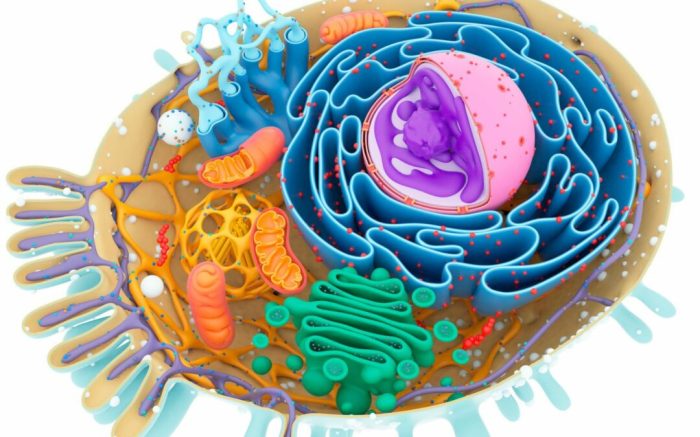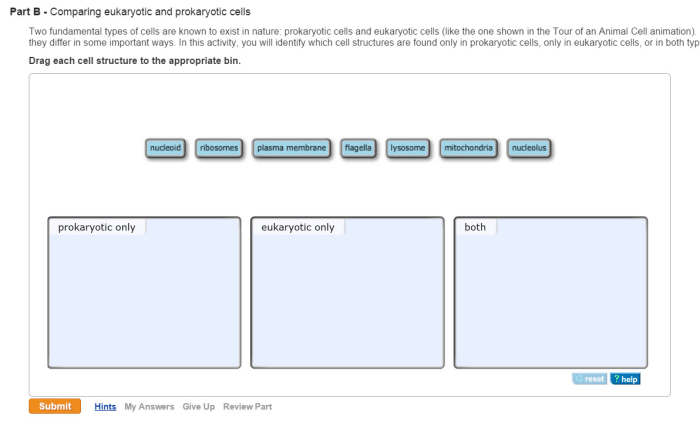Drag each cell structure to the appropriate bin – Delving into the realm of cell biology, we embark on a journey to explore the intricate world of cell structures and their meticulous organization within the cell. This comprehensive guide, “Drag Cell Structures to Their Bins,” unravels the secrets of these cellular components, shedding light on their diverse functions and the intricate interplay that governs their interactions.
As we delve deeper into the topic, we will dissect the various types of cell structures, examining their unique roles and the mechanisms that orchestrate their harmonious coexistence. Through engaging explanations and illustrative examples, we will gain a profound understanding of how these structures contribute to the overall functioning, growth, and development of cells.
Cell Structure Overview

A cell structure refers to the specialized components and organelles within a cell that perform specific functions essential for cell viability and function. These structures include the cell membrane, nucleus, mitochondria, endoplasmic reticulum, Golgi apparatus, and many others.
Types of Cell Structures
| Name of Cell Structure | Function of Cell Structure | Location of Cell Structure | Image of Cell Structure |
|---|---|---|---|
| Cell Membrane | Regulates the movement of substances into and out of the cell | Surrounds the cell | [Image of cell membrane] |
| Nucleus | Contains the cell’s genetic material | Center of the cell | [Image of nucleus] |
| Mitochondria | Produces energy for the cell | Cytoplasm | [Image of mitochondria] |
| Endoplasmic Reticulum | Synthesizes and transports proteins | Cytoplasm | [Image of endoplasmic reticulum] |
| Golgi Apparatus | Modifies and packages proteins | Cytoplasm | [Image of Golgi apparatus] |
Cell Structure Organization
Cell structures are organized within a cell in a specific manner to facilitate efficient functioning. The cytoskeleton, a network of protein filaments, plays a crucial role in organizing cell structures by providing structural support and facilitating movement within the cell.
A typical eukaryotic cell, such as an animal cell, exhibits a hierarchical organization of its structures. The nucleus is the most prominent structure, surrounded by the cytoplasm, which contains various organelles and structures enclosed by membranes. The cytoskeleton extends throughout the cytoplasm, providing structural support and facilitating the movement of organelles and other cellular components.
[Diagram of a cell showing the organization of its structures]
Cell Structure Interactions, Drag each cell structure to the appropriate bin
Cell structures interact with each other in a coordinated manner to maintain cellular homeostasis and perform various functions. Cell signaling pathways facilitate communication between cell structures, enabling them to respond to changes in the internal and external environment.
For instance, the endoplasmic reticulum synthesizes proteins that are then modified and packaged by the Golgi apparatus. These proteins are then transported to the cell membrane for secretion or to other cellular compartments for further processing. Such interactions between cell structures are essential for maintaining cellular function and coordinating cellular responses.
Cell Structure Dynamics
Cell structures are not static but rather dynamic and undergo changes over time. Cell division is a fundamental process that results in the creation of new cell structures. During cell division, the cell’s genetic material is duplicated and distributed to two daughter cells, along with the necessary organelles and structures to sustain life.
Cell structure dynamics also contribute to cell growth and development. As a cell grows, it synthesizes new cell structures to meet the increasing demands of the cell. During development, cells differentiate into specialized cell types, each with a unique set of cell structures adapted to perform specific functions.
Essential FAQs: Drag Each Cell Structure To The Appropriate Bin
What is the significance of cell structure organization?
The organization of cell structures is crucial for maintaining cellular integrity, facilitating efficient cellular processes, and ensuring proper cell function.
How do cell structures interact with each other?
Cell structures interact through various mechanisms, including direct physical contact, signaling molecules, and the cytoskeleton, enabling coordinated cellular activities.
What is the role of cell division in cell structure dynamics?
Cell division plays a pivotal role in cell structure dynamics by creating new cells and distributing existing structures to daughter cells, ensuring the continuity of cellular components.

